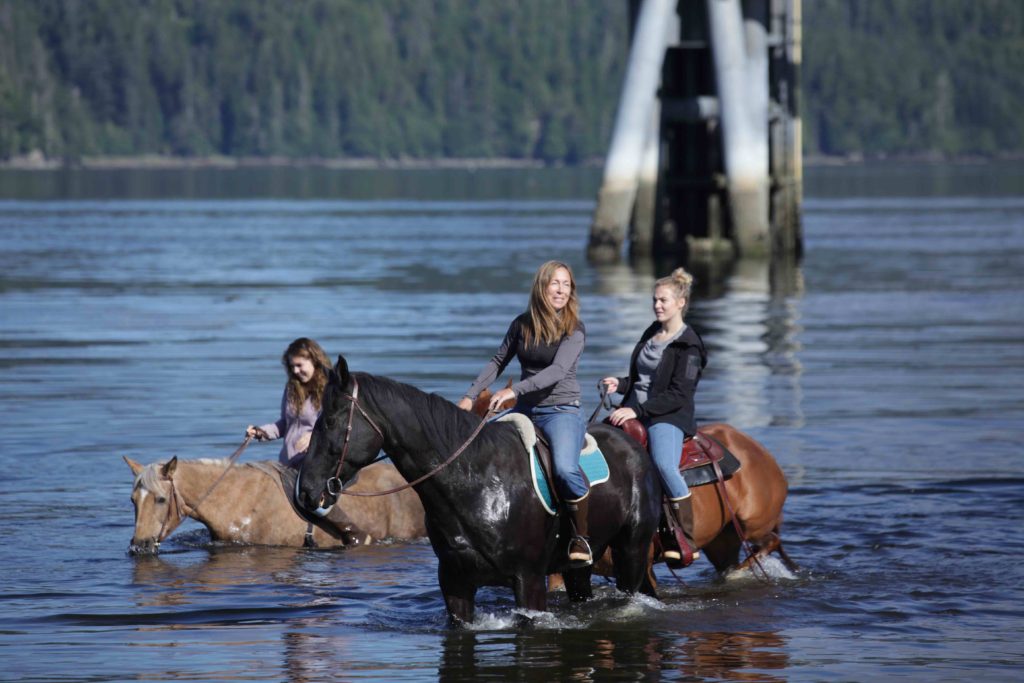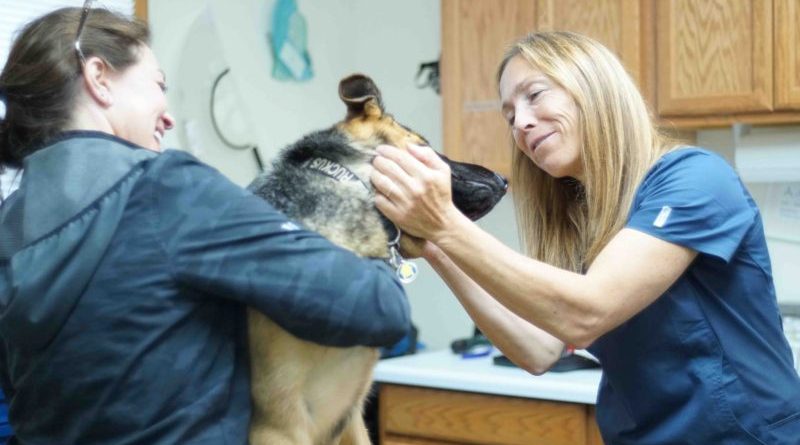INTERVIEW: Dr. Oakley loves the adventure of the Yukon
Photo: Kim Chetney gives her dog Ruckus a nice hug while Dr. Michelle Oakley massages some ear drops in, something Ruckus enjoys greatly. Photo courtesy of Lucky Dog Films/Miranda Langevin / Provided by Nat Geo Press Room with permission.
Dr. Michelle Oakley is the go-to veterinarian in the Yukon region of Alaska and northern Canada. She is an animal lover who never has a typical day at the office. That’s because she is often taken away from the confines of her veterinary clinic and forced to make house calls in the remote regions of the northern regions of planet Earth.
But it’s all in a day’s work for the realty TV star, whose adventures are featured on Dr. Oakley, Yukon Vet. New episodes air Saturdays at 9 p.m. on Nat Geo WILD.
There isn’t an animal, either domesticated or wild, that Oakley hasn’t seen and treated in her winter wonderland. She has taken care of bison, ibex, bears and boars. Oh my!
Recently Hollywood Soapbox exchanged emails with Oakley about her animal adventures. Questions and answers have been slightly edited for style.
What do you love most about the Yukon region?
I love that it’s this hugely vast, complete, intact ecosystem. The Yukon is still wild; it’s one of the wildest places on earth. I love that there are more moose than people. The Yukon is home to all these amazing wildlife populations, and the people who live there are pretty cool, too. Out there, it’s nothing to be ‘off the grid.’ Everyone is innovative and self-reliant, and in moments when people can’t be self-reliant, they help each other — there’s a strong sense of community.
How did you train to be an all-species vet? Does that require more years in veterinary school?
I did an extra year as an internship with the Calgary Zoo, and I’ve worked as a wildlife vet for the Yukon government. I’ve also worked internationally with wildlife in places like Sri Lanka and Costa Rica, which seems like that work wouldn’t be similar to what I do in the Yukon, but it is. At the end of the day, it’s about trying to help these different species, figuring out what’s ailing them, and making do with vet gear and tools that were not made for these types of animals.
Nothing is designed for a bison or a sea lion or a grizzly bear; animals can be super-sized or tiny. Sometimes I’m working on bats that weigh only 50 grams. You can’t learn how to treat every species, but what I learned in vet school was how to keep learning, figure out the gold standard for patients and adapt that to whatever the reality of the situation is. So much of this job is being innovative and making things work for your patients.
Is it still an emotional experience when an animal unfortunately has to be put down? Do you ever get used to that reality?
When it stops being an emotional experience, it’s a bad sign. It’s important to be strong and professional for the people involved, so we can make sure the animal goes peacefully. The reason people put their animals down is because they don’t want to see them suffer anymore, and it is my job to see that the animal has a peaceful escort out of this world. It’s the most bittersweet thing I do.

What kind of conditions and illnesses do you see amongst animals in the Yukon that vets in the lower 48 may never see or rarely see?
Bear attacks, especially at this time of year. There are a lot of people out fishing and hiking, and bears are out there, too. I see a lot of dogs that have been stomped on by a moose; a dog will get too curious, and moose react quickly. I also see trauma cases from coyotes, but bear and moose trauma are the most common. And while there are porcupine in other places, I definitely see a lot of those cases.
In the deep snows of winter, does your job become even more difficult? How do you access emergency situations?
In the winter, everything gets harder, and it can slow you down. The wonderful part about working in the snow is that everything is clean. It’s a clean spot to do a surgery — no dust or dirt, and animals don’t overheat, which can happen with larger species.
But trying to get around is difficult. Often you have to go by snowmobile, and then sometimes you have to switch to another mode of transportation to get where you need to go. I have a Toyota 4Runner with big tires that gets me to a lot of places most vehicles can’t, and I know how to drive in the snow. Sometimes we have to use a helicopter, not just because of the snow but because of the distance we need to travel, and then I’ll use snowshoes to trek after getting out of the helicopter.
Dr. Oakley added some information about adventures on the new season …
There’s an incredible story of a dog who was in a house fire — the house burned down, and the dog was chained to the house. Rescuers found him 6 miles away, [and] they drove him to the clinic in a seven-hour drive that normally takes two to threee hours. The dog had burns on 50-60 percent of his body, and the owner would not give up on him.
The show follows the dog’s progress; it’s an amazing story, and I learned some new techniques while treating him. That case represented everything about the Yukon — yes, it’s an isolated place, but we all work together and do what we can to help each other.
By John Soltes / Publisher / John@HollywoodSoapbox.com
Dr. Oakley, Yukon Vet continues with new episodes Saturdays at 9 p.m. on Nat Geo WILD. Click here for more information.

